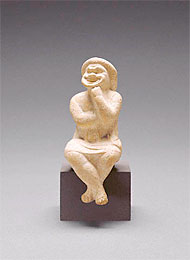 |
 |
 |
 |
Grades/Level: Lower Elementary (K–2), Upper Elementary (3–5)
Subjects: Visual Arts, Theater
Time Required: Long–Term Unit
Six 30-minute class periods
Author: J. Paul Getty Museum Education Staff
Permissions: 
The lesson plan and downloadable materials on this page are licensed under a Creative Commons Attribution 4.0 International License. |
 |
|
 |
 |
 |
 |
 |
 |
 |
Lesson Overview |
 |
Students will examine and discuss an ancient Greek statuette depicting a comic actor and an ancient Roman lamp decorated with a comic theater mask. Students will learn about stock characters and create comic masks for characters. They will work in teams to pantomime a short scene while wearing their masks. |
 |
 |
 |
 |
 |
Learning Objectives |
 |
Students will be able to:
• describe how stock characters have been portrayed in theater and works of art.
• identify lines and shapes in a work of art.
• create a comic theater mask.
• pantomime short scenes. |
 |
 |
 |
 |
 |
 |
 |
 |
 |
Materials |
 |
• Reproduction of Statuette of a Comic Actor by an unknown Greek artist
• Reproduction of Lamp in the Shape of a Comic Mask by an unknown Roman artist
• Background Information and Questions for Teaching about the statuette and lamp
• Student Handout: "Emotion Cards"
• Internet access
• A figurine of a comic actor or cartoon character (i.e., Jim Carrey doll, Toy Story figurine) or an object that displays a comic actor or cartoon character (i.e., SpongeBob SquarePants pencil holder, Shrek drinking glass)
• Information and activities in the "Understanding Formal Analysis" section on the Getty website (optional)
• Projector
• Dry-erase markers
• Student Handout: "Who, What, and Where?"
• Student Handout: "The Shapes of Characters"
• Paper
• Pencils
• Art Activity: "Paper Theater Masks" (PDF, 505KB, 3 pp.)
• 8 1/2 x 11 inch paper cut into approximately eight 1 x 11 inch strips (one strip per student)
• Heavy sheets of paper (i.e., construction paper or cut sides of brown paper bags)
• Scissors
• Colored pencils, crayons, or markers
• Hole punches
• Elastic or yarn
• Glue or tape
• Assorted decorative materials, such as foil, recycled fabric, scrap construction paper, raffia, and yarn (optional) |
 |
 |
 |
 |
 |
|
|
 |
 |
 |
 |
 |
Lesson Steps |
 |
Download the complete lesson by clicking on the "download this lesson" icon above.
Glossary Terms:
Words in bold on these pages and in the lesson are defined in the glossary for this curriculum (see "Performing Arts in Art Contents" links above). |
 |
 |
 |
| Statuette of a Comic Actor, unknown Greek artist, 325–275 B.C. |
 |
|
 |
 |
 |
 |
 |
 |
 |
Standards Addressed |
 |
Common Core Standards for English Language Arts
Grades K–5
SPEAKING AND LISTENING
K.1 Participate in collaborative conversations with diverse partners about kindergarten topics and text with peers and adults in small and larger groups.
1.3 Ask and answer questions about what a speaker says in order to gather additional information or clarify something that is not understood.
1.4 Describe familiar people places, things, and events, with relative details expressing ideas and feelings more clearly.
2.4 Tell a story or recount an experience with appropriate facts and relevant, descriptive details, speaking audible in coherent sentences.
3.4 Report on a topic or text, tell a story, or recount an experience with appropriate facts and relevant, descriptive details, speaking clearly at an understandable pace.
4.1 Engage effectively in a range of collaborative discussions (one-on-one, in groups, and teacher-led) with diverse partners on grade 4 topics and texts, building on others' ideas and expressing their own clearly.
4.6 Differentiate between contexts that call for formal English (e.g., presenting ideas) and situations where informal discourse is appropriate (e.g., small-group discussion); use formal English when appropriate to task and situation. (See grade 4 Language standards 1 and 3 for specific expectations.)
5.1 Engage effectively in a range of collaborative discussions (one-on-one, in groups, and teacher-led) with diverse partners on grade 5 topics and texts, building on others' ideas and expressing their own clearly.
5.6 Adapt speech to a variety of contexts and tasks, using formal English when appropriate to task and situation. (See grade 5 Language standards 1 and 3 for specific expectations.)
|
 |

|
 |
 |
 |





